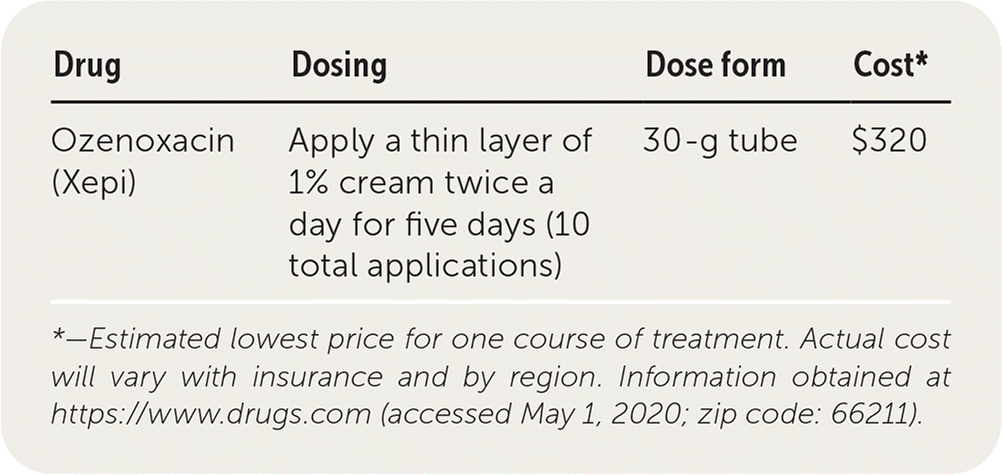
Am Fam Physician. 2020;101(12):760-761
Author disclosure: No relevant financial affiliations.
Ozenoxacin (Xepi) is a topical quinolone antibiotic approved for the treatment of bullous or nonbullous impetigo in adults and children older than two months. It is bactericidal against common causative organisms of impetigo, including Staphylococcus aureus (methicillin-susceptible and -resistant isolates) and Streptococcus pyogenes.1

| Drug | Dosing | Dose form | Cost* |
|---|---|---|---|
| Ozenoxacin (Xepi) | Apply a thin layer of 1% cream twice a day for five days (10 total applications) | 30-g tube | $320 |
Safety
No significant local or systemic adverse effects have been identified in clinical trials of 362 adults and children treated with ozenoxacin.2,3 Although topical application results in minimal systemic absorption, pregnant and lactating women were not included in the trials and should not take this medication. Ozenoxacin should not be used in patients with underlying eczematous dermatitis because it has not been studied in this patient population.
Tolerability
Ozenoxacin is well-tolerated. In clinical trials, no patients discontinued treatment. One patient experienced rosacea and seborrheic dermatitis after taking ozenoxacin.3
Effectiveness
Ozenoxacin has been studied in two randomized placebo-controlled trials that included 723 adults and children two months or older with bullous or nonbullous impetigo. Total lesion size was 2 cm2 to 100 cm2 or no more than 2% body surface area in patients younger than 12 years. Patients also had mild pus or exudate with the level of infection determined to be mild to moderate in trial 1 and severe in trial 2.2,3 Infections were categorized based on the presence and severity of exudate, pus, crusting, erythema and inflammation, tissue warmth, tissue edema, itching, and pain. Evaluation of clinical success occurred after patients completed five days of treatment with ozenoxacin or placebo. Clinical success occurred significantly more often with ozenoxacin than placebo in patients with severe infection (34.8% vs. 19.2%; number needed to treat [NNT] = 7) compared with patients with mild to moderate infection (54.8% vs. 37.9%; NNT = 6).2,3 Although not statistically compared, clinical success rates were similar with ozenoxacin and topical retapamulin (Altabax; 34.8% vs. 37.7%, respectively).
Children two years to 12 years of age were the largest group of patients included in the trials (48.3% in trial 1 and 61% in trial 2). In both trials, nonbullous impetigo was the most common diagnosis and occurred in 80% to 86% of patients. S. aureus was the most commonly isolated organism in both trials, affecting 65% of patients with more severe infections and 51% of those with mild to moderate infections. S. pyogenes was more commonly isolated in patients with more severe infections (51%) than less severe (9.5%).2,3 Ozenoxacin has not been studied for the treatment of impetigo in patients with systemic signs and symptoms requiring oral antibiotic treatment. Ozenoxacin has not been compared with mupirocin in a randomized controlled trial.4
Price
One 30-g tube of 1% ozenoxacin cream costs about $320. It is similar in price to retapamulin 1% ointment, which costs about $350 for one 15-g tube. In comparison, one 22-g tube of mupirocin 2% ointment costs approximately $55.
Simplicity
Ozenoxacin is applied twice a day for five days (a total of 10 applications) to complete a full treatment course. This is the same regimen recommended for retapamulin and the same duration recommended for mupirocin, which is applied three times a day. Patient access to ozenoxacin is limited because it is only available through specialty independent pharmacies (see https://www.xepicream.com/).
Bottom Line
Ozenoxacin is an effective and safe topical quinolone treatment for bullous and nonbullous impetigo in patients as young as two months. However, it is expensive and some patients may have limited access because it is only available through a physician or hospital. There is no direct evidence that it is superior to mupirocin.
